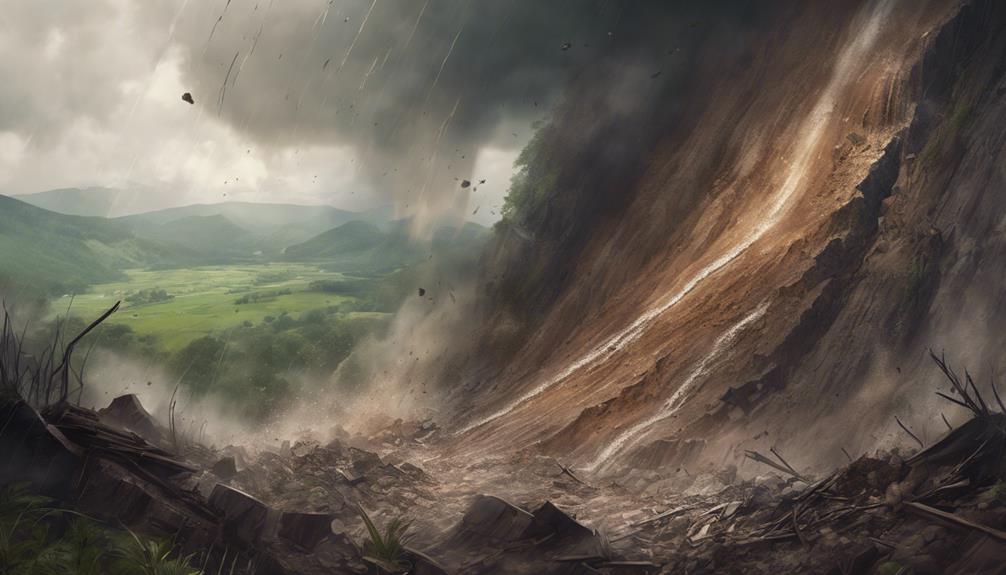Landslides, a natural geohazard, present a complex interplay of geological, environmental, and anthropogenic factors leading to slope failures. From the intricate balance of soil composition to the impact of human activities on terrain stability, understanding the mechanics behind landslides is paramount in mitigating their destructive consequences. As we delve deeper into the underlying causes of landslides, a clearer picture emerges of the intricate web of forces at play in shaping our landscapes.
Key Takeaways
- Heavy rainfall, erosion, and steep slopes weaken soil stability, leading to landslides.
- Human activities like construction and deforestation can increase landslide risks.
- Vegetation removal diminishes natural stabilization, enhancing slope instability.
- Improper irrigation practices can saturate soil, reducing cohesion and triggering landslides.
Heavy Rainfall and Soil Saturation

During periods of heavy rainfall, the increased water weight in the soil can critically destabilize slopes, leading to heightened susceptibility to landslides. Heavy rains saturate the soil, reducing its strength and cohesion, making it more prone to sliding. The infiltration of water into the ground can also decrease soil friction, triggering landslides. Prolonged or intense rainfall saturates slopes, causing them to fail and slide downhill. The increased water content acts as a lubricant, facilitating landslide movement by reducing the resistance between soil particles.
Saturated soil loses its ability to hold together, increasing the likelihood of slope failure. The added weight from the water further stresses the slope, potentially surpassing its stability threshold. Understanding the relationship between heavy rains and soil saturation is crucial in assessing landslide risks and implementing preventive measures. Monitoring soil moisture levels and drainage systems can help mitigate the impact of heavy rainfall on slope stability, reducing the occurrence and severity of landslides.
Earthquake Shaking Effects
The effects of earthquake shaking on slope stability are significant, as seismic activity can weaken slope materials and elevate the risk of landslides in vulnerable regions. Earthquake shaking can induce the movement of material on slopes, leading to potentially hazardous situations. Understanding the impact of seismic events on slope stability is crucial for mitigating landslide risks in earthquake-prone areas.
| Effects of Earthquake Shaking on Slope Stability |
|---|
| – Weakens slope materials |
| – Increases susceptibility to landslides |
| – Induces movement of material on slopes |
| – Elevates landslide risk in vulnerable regions |
| – Requires comprehensive risk assessments |
Monitoring seismic activity is essential for predicting and preparing for potential landslides triggered by earthquakes. Post-earthquake landslides can have devastating consequences, underscoring the importance of studying the relationship between earthquake shaking and slope stability. By conducting thorough risk assessments and staying vigilant in monitoring seismic events, communities can enhance their preparedness and resilience to earthquake-induced landslides.
Slope Modifications Impact
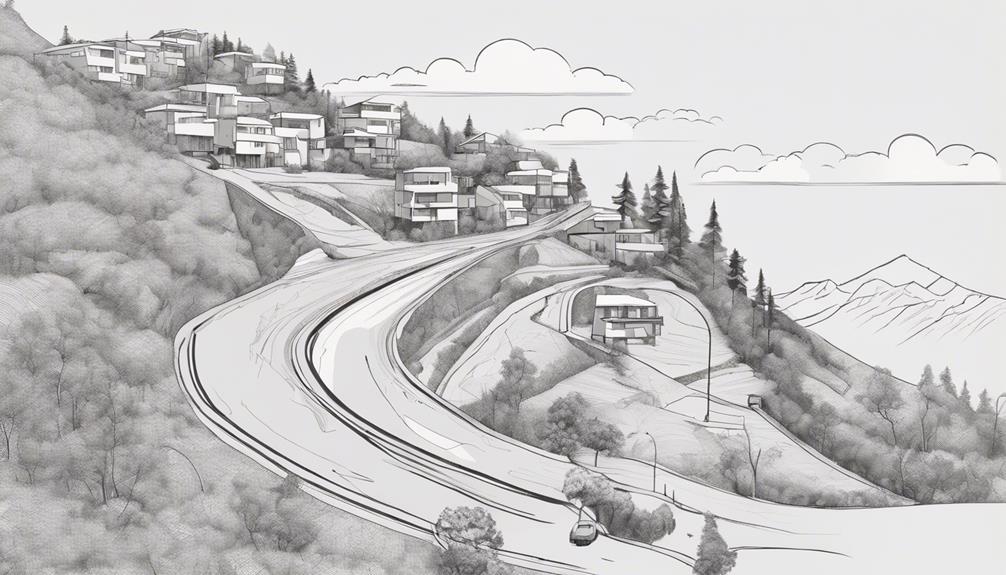
How do human activities influence the stability of slopes and contribute to the occurrence of landslides? Slope modifications play a crucial role in increasing landslide risk when not executed thoughtfully. Poorly planned construction activities that involve altering slopes can destabilize the terrain, making it more susceptible to landslides. Inadequate grading practices can exacerbate erosion, leading to slope failure and a higher likelihood of landslides. Furthermore, disturbing old landslides through construction work can escalate the chances of new landslides occurring in the area. Human-induced changes in drainage patterns also significantly impact slope stability, further increasing the potential for landslides to happen. To mitigate these risks, detailed on-site investigations are essential to evaluate the impact of human activities on slope modifications and assess the susceptibility of the area to landslides accurately. Understanding the implications of slope modifications is crucial in ensuring the stability of the terrain and minimizing the occurrence of landslides.
Vegetation Removal Consequences
The consequences of vegetation removal on slopes are significant. Removing vegetation diminishes the stabilizing effect of root systems, increasing the likelihood of slope instability and landslides. Additionally, the absence of vegetation results in heightened water runoff, saturating slopes and further exacerbating erosion risks.
Deforestation Impact on Landslides
Significant deforestation exacerbates the occurrence of landslides by disrupting the natural stabilizing effects of vegetation on slopes. When trees are removed, their roots can no longer bind the soil together, increasing the likelihood of erosion and landslides. The loss of vegetation also results in higher surface runoff during rainfall, which can trigger landslides. Deforested areas are especially vulnerable to landslides during heavy rain events due to this lack of natural protection. The removal of vegetation upsets the balance on slopes, making them more susceptible to mass movement.
| Deforestation Impact on Landslides |
|---|
| – Increases landslide risks |
| – Disrupts natural stabilization |
| – Elevates surface runoff |
Soil Erosion Risks
After the disruption of vegetation through deforestation, the consequences of soil erosion risks become pronounced, heightening the vulnerability of slopes to landslides. Vegetation removal plays a crucial role in increasing landslide susceptibility by diminishing the binding effect that plant roots exert on soil stability. This reduction in root reinforcement exposes slopes to accelerated soil erosion risks, thereby making them more prone to landslides. Deforestation and land clearing activities further exacerbate soil erosion hazards, as the loss of vegetation cover weakens soil cohesion and leaves slopes susceptible to erosion. The removal of trees and plants significantly destabilizes slopes, contributing to heightened landslide risks due to the decreased stability of the soil. Understanding these soil erosion risks post-vegetation removal is essential in assessing and mitigating landslide vulnerabilities.
Tree Root Stabilization
Root stabilization by trees is a fundamental factor in maintaining slope stability and preventing erosion. Tree roots bind soil particles together, reducing the risk of landslides by increasing soil cohesion. When vegetation, including trees, is removed, the soil becomes more prone to erosion and landslides due to the loss of root reinforcement. Tree roots also help prevent shallow landslides by anchoring soil layers, which further emphasizes their importance in slope stability. Without the presence of tree roots, slopes are more susceptible to increased water infiltration rates, leading to a weakening of the soil and an elevated risk of landslides. Therefore, preserving tree roots and vegetation is crucial in mitigating landslide hazards and maintaining slope stability.
Excavation and Debris Piling
Excavation activities and debris piling are key factors contributing to the destabilization of natural slopes, thereby heightening the vulnerability to landslides. Improper handling of these activities can disturb the delicate balance of the land, increasing the likelihood of slope failures. Here are some key points to consider:
- Excavation activities can disturb natural slope stability, increasing the risk of landslides.
- Piling debris during construction can alter the balance of slopes, leading to potential landslide triggers.
- Inadequate planning and management of excavation and debris can significantly impact slope stability.
- Human activities like excavation and debris piling play a crucial role in increasing landslide susceptibility.
- Proper measures during excavation and debris management are essential to mitigate landslide risks effectively.
Understanding the impact of excavation and debris piling on slope stability is crucial for preventing landslides. By implementing proper planning and management strategies, the risks associated with these activities can be minimized, ultimately contributing to safer environments.
Irrigation Influence on Slopes
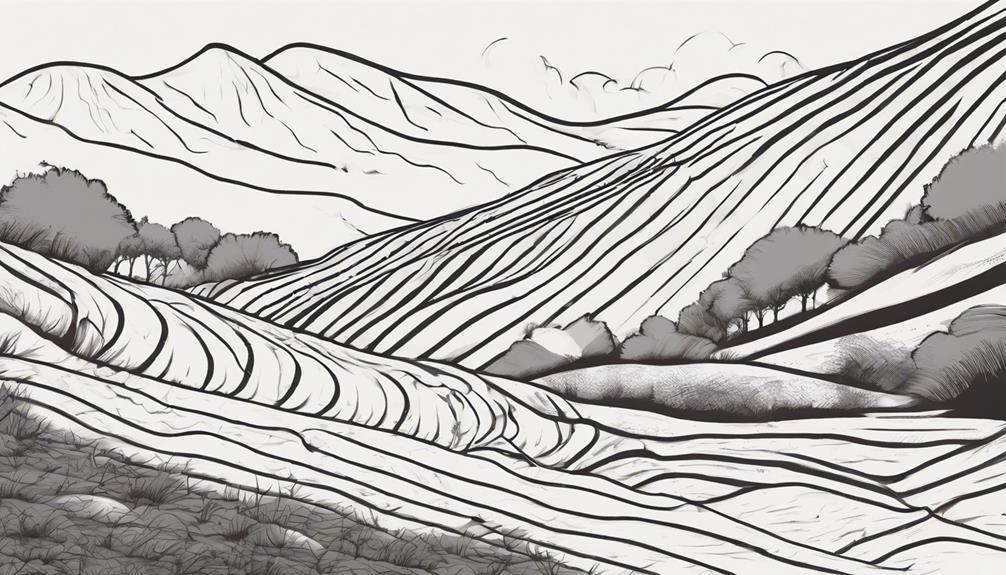
Irrigation practices significantly influence the stability of slopes through their impact on soil weight and moisture levels. Over-irrigation can saturate the soil, reducing its strength and cohesion, making it more prone to sliding. Changes in soil moisture levels due to irrigation can trigger slope failures and landslides. Irrigation can increase the weight of soil on slopes, contributing to instability and potential landslides. Additionally, irrigation practices that lead to water accumulation on slopes can increase the risk of mass movements. Proper irrigation management is crucial to prevent soil saturation and maintain slope stability, reducing landslide hazards.
| Aspect | Influence |
|---|---|
| Soil Weight | Increases due to water content, adding pressure to the slope, potentially leading to failure |
| Moisture Levels | Excessive irrigation can saturate soil, reducing its cohesion and stability |
| Slope Stability | Proper irrigation management is essential to minimize landslide risks |
Surface Water Rerouting Risks
The alteration of natural surface water drainage patterns poses a significant risk of triggering landslides through destabilizing slopes and saturating soil. Changes in surface water flow, often caused by human activities such as construction or urban development, can have detrimental effects on slope stability and soil saturation levels, increasing the likelihood of landslides. Key points to consider regarding surface water rerouting risks include:
- Rerouting surface water can alter natural drainage patterns, disrupting the balance of water flow across slopes.
- Changes in surface water flow due to human activities like construction can destabilize slopes by increasing water infiltration.
- Redirected runoff can saturate soil, reducing its stability and making it more prone to sliding.
- Disrupted natural drainage systems may lead to concentrated water flow, accelerating erosion and landslide potential.
- Understanding the impact of surface water rerouting is crucial in landslide monitoring and assessing and mitigating landslide risks in vulnerable areas.
Rock and Soil Weakness
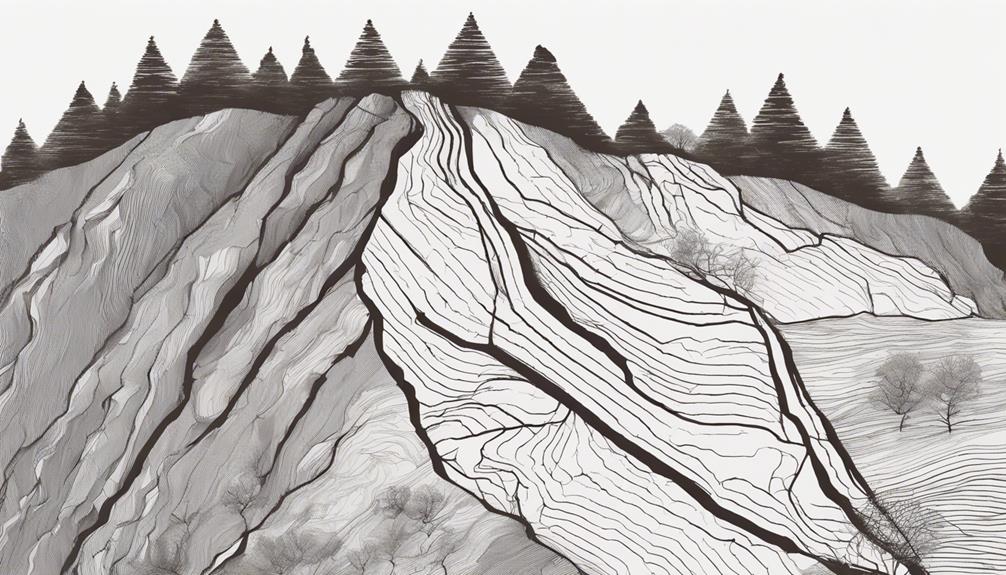
What factors contribute to the vulnerability of rock and soil to landslides? Rock and soil weakness play a critical role in the occurrence of landslides. When these materials lose their cohesion and strength, they become susceptible to movement. Weakness in rock and soil can stem from various factors such as weathering, erosion, and geological processes. Geological faults and fractures also contribute significantly to the instability of rock and soil, further increasing the likelihood of landslides. These faults create zones of weakness where materials are more prone to failure and displacement. Additionally, human activities like mining, construction, and deforestation can exacerbate rock and soil weakness, making them more prone to landslides. Understanding the specific vulnerabilities within rock and soil formations is essential for accurately assessing landslide risks and implementing effective mitigation strategies. By addressing these weaknesses, it is possible to reduce the potential impact of landslides on communities and infrastructure.
Construction Activities Impact
Rock and soil weakness caused by various factors, including natural processes and human activities, sets the groundwork for understanding the impact of construction activities on landslide vulnerability. Construction activities play a significant role in altering the landscape and can have detrimental effects on slope stability, increasing the likelihood of landslides. Here are some key points to consider:
- Construction activities like grading for roads or buildings can destabilize slopes, increasing the risk of landslides.
- Alterations in surface water flow patterns during construction can trigger landslides by changing natural drainage pathways.
- Excavation and piling debris on slopes can impact the stability of the land, leading to potential landslide occurrences.
- Vegetation removal, often necessary for construction projects, can significantly increase the susceptibility of an area to landslides.
- Human-induced changes to the landscape through construction can disrupt the natural balance of slope stability, contributing to landslide risks.
These factors highlight the importance of considering slope stability during construction activities to mitigate the risk of landslides.
Environmental Factors Contributing
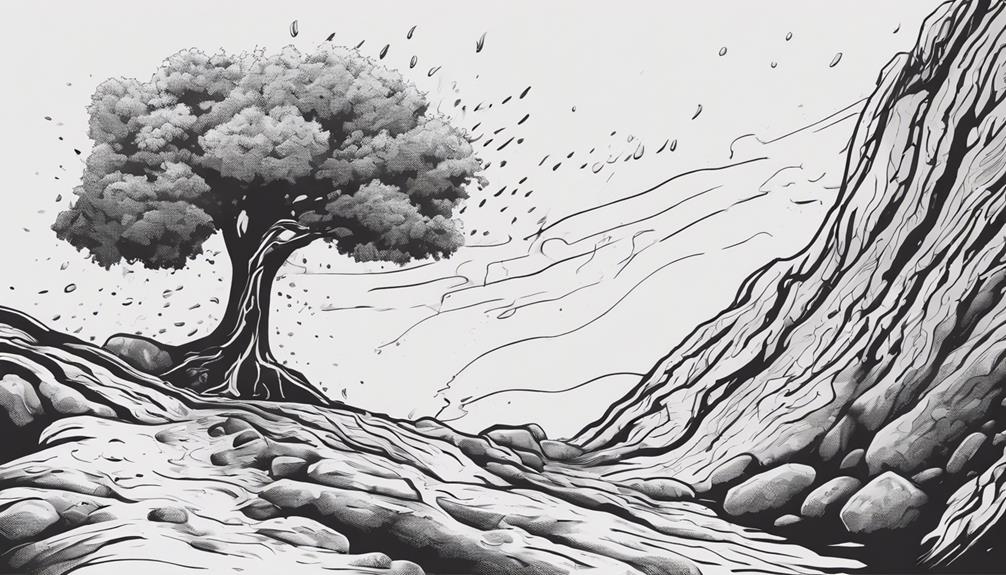
Heavy rainfall, erosion, steep slope angles, rock type, and weathering processes are key environmental factors that contribute significantly to the occurrence of landslides. Heavy rainfall can saturate slopes, increasing pore water pressure and reducing soil strength, leading to slope failures. Erosion, particularly from water sources like streams, rivers, and wave action, can undermine the base of slopes, making them susceptible to landslides. Steep slope angles enhance the gravitational forces acting on materials, making them more likely to slide downhill. The type of rock also plays a crucial role, as softer rocks are more prone to failure than harder, more competent rocks. Additionally, weathering processes like freeze-thaw cycles and chemical weathering can weaken slope materials, reducing their stability and increasing the likelihood of landslides.
| Environmental Factors | Description |
|---|---|
| Heavy Rainfall | Saturates slopes, reducing soil strength. |
| Erosion | Undermines slope bases, increasing instability. |
| Steep Slope Angles | Enhance gravitational forces, promoting sliding. |
| Rock Type | Soft rocks are more vulnerable to failure. |
| Weathering Processes | Weaken material cohesion, making slopes less stable. |
Warning Signs and Prevention
Understanding the indicators and strategies for preventing landslides is paramount in mitigating their destructive impact on vulnerable landscapes and communities. Geologic Hazards Science provides valuable insights into recognizing warning signs and implementing preventive measures. Some key points to consider include:
- Warning signs of an impending landslide include ground cracks, tilting trees, and sudden water flow changes.
- Monitoring rainfall intensity and slope stability can help prevent landslides.
- Implementing proper drainage systems and avoiding construction on steep slopes are key prevention measures.
- Early evacuation planning based on landslide risk assessments is crucial for minimizing casualties.
- Community education on recognizing landslide risks and response protocols is essential for preparedness.
Frequently Asked Questions
What Is a Major Cause of Landslides?
A major cause of landslides is the loss of cohesion and strength in rock or soil, contributing to their susceptibility. Additionally, human activities such as deforestation and urban development can exacerbate soil erosion dynamics, further destabilizing slopes. These factors, combined with the impact of climate change, can increase the frequency and severity of landslides. Understanding these interactions is crucial for effective prevention and prediction strategies.
What Are the 3 Main Triggers of Landslides?
Natural disasters like heavy rainfall and earthquakes, along with geological processes, are the primary triggers of landslides. Heavy rainfall saturates the ground, reducing stability and causing slope failure. Earthquakes shake loose rocks and soil on slopes, initiating landslides. These triggers, exacerbated by human activities like construction and deforestation, alter slope stability and contribute to the occurrence of landslides. Understanding these factors is critical for mitigating landslide risks and ensuring environmental safety.
Where Do Most Landslides Occur?
Landslides predominantly occur in coastal cliffs and urban areas, posing significant risks to communities. A striking statistic reveals that approximately 25-50 landslides happen annually in the United States alone. Coastal regions face the menace of unstable cliffs prone to landslides, while urban areas with extensive construction are also vulnerable. Understanding these patterns is crucial for implementing effective mitigation strategies to minimize the impact of landslides on human lives and infrastructure.
Why Do Landslides Happen on Mountains?
Mountain erosion, influenced by topography and geological conditions, creates steep slopes prone to landslides. Climate factors such as heavy rainfall and snowmelt saturate the soil, weakening slopes. Earthquakes in mountainous areas can induce landslides due to ground shaking and instability. Human activities like deforestation exacerbate the situation. The combination of these factors on mountain landscapes increases the likelihood of landslides occurring in these regions.
Conclusion
In conclusion, the causes of landslides are multifaceted, ranging from natural phenomena like heavy rainfall and earthquakes to human activities such as deforestation and construction. Understanding these factors is crucial in mitigating the risks associated with landslides. As the saying goes, "an ounce of prevention is worth a pound of cure," it is imperative to take proactive measures to prevent and reduce the impacts of landslides on vulnerable areas.
